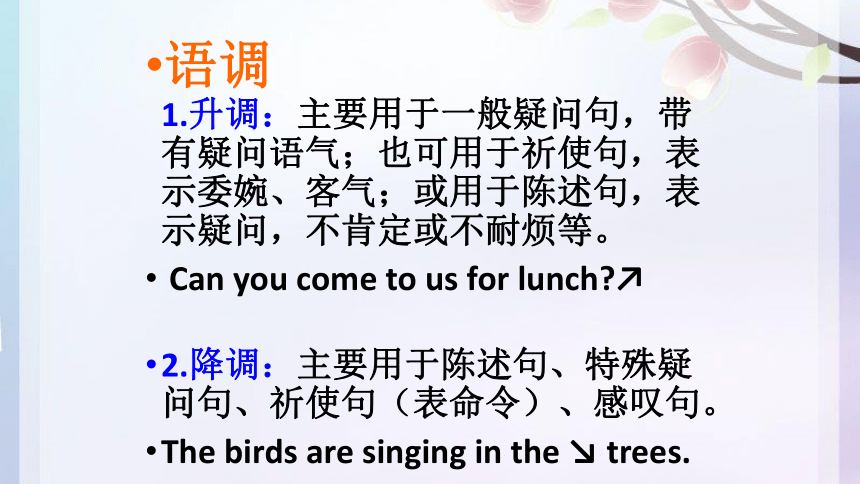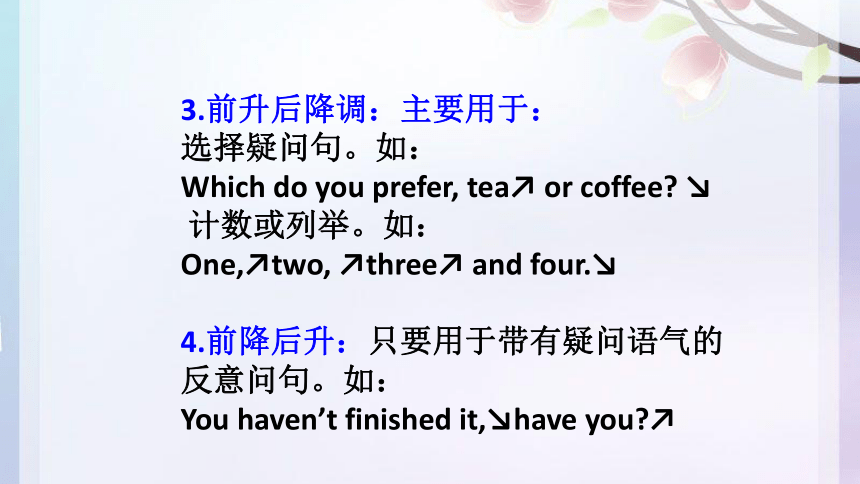2022届高考口语考试听说训练技巧课件 20张PPT
文档属性
| 名称 | 2022届高考口语考试听说训练技巧课件 20张PPT |  | |
| 格式 | pptx | ||
| 文件大小 | 114.7KB | ||
| 资源类型 | 教案 | ||
| 版本资源 | 通用版 | ||
| 科目 | 英语 | ||
| 更新时间 | 2021-07-07 22:14:39 | ||
图片预览









文档简介
听说训练技巧
Computer- based English
Listening and Speaking Test
Part A Read aloud
语调
1.升调:主要用于一般疑问句,带有疑问语气;也可用于祈使句,表示委婉、客气;或用于陈述句,表示疑问,不肯定或不耐烦等。
Can you come to us for lunch?↗
2.降调:主要用于陈述句、特殊疑问句、祈使句(表命令)、感叹句。
The birds are singing in the ↘ trees.
3.前升后降调:主要用于:
选择疑问句。如:
Which do you prefer, tea↗ or coffee? ↘
计数或列举。如:
One,↗two, ↗three↗ and four.↘
4.前降后升:只要用于带有疑问语气的反意问句。如:
You haven’t finished it,↘have you?↗
.连读
1.(词末)辅音+(词首)元音
It is an old book. Not at all First of all
2.(词末)r/re+(词首)元音
I looked for it here and there.
3.(词末)辅音+(词首)半元音
英语语音中的/j/和/w/是半元音,如果前一个词是以辅音结尾,后一个词是以半元音(特别是/j/)开头,此时也要连读。
Thank you.
Nice to meet you.
︶
︶
.失爆
当前面一个单词的最后一个音是辅音,后面一个单词的第一个音也还是辅音,那么前面一个单词的最后一个辅音一般可以不发出来。
失爆练习(下划线部分为失爆部分)
at most keep track of
stop the car cab-driver
keep quiet kick the ball
Good morning
重读
一般规则:实词重读,虚词不重读。
(1)名词、形容词、数词、动词、副词是实词,一般要重读。
(2)冠词、介词、连词、助动词是虚词,一般不重读。
例如:Janet has gone to school.
He is a tall young man with blue eyes.
Who is coming? ---I am.
意群
句子可以按照它的意思和语法结构分成小段,这样的小段就叫意群。意群可以是一个词,一个短语,也可以是并列句中的一个分句或复合句中的一个主、从句等。
如下面的句子可以这样划分意群:
(1)Tonny only walks a few steps/from
his office/to the place/where his wife
works.
There are thousands of islands in the South Pacific. Many are unbelievably remote. Some are thousands of miles away from the nearest continent and hundreds of miles from their nearest neighbor. It’s a wonder how any life reached these islands at all. But no matter how remote or small an island is, animals have somehow conquered the massive ocean barrier to reach these specks of land. For the lucky few that made it, South Pacific islands provided great opportunities. The size of many South Pacific islands means that food is often limited. The smaller and more isolated they are, the harder it is to survive.
Part B Role play
1.根据对话预测问题
2.听时快速记录重要细节:人物、事物、时间、地点、行为、对象、数字、年代,单价,折扣价,门牌号等(5w1h)以及信息间的联系。同时,用最简洁的符号记录信息。
3.提问部分
注意选好疑问词(5w1h:who,when,where, what,why,how), 确定用一般疑问句还是特殊疑问句
提问时注意使用语法正确的句子,尤其是疑问句的语序和时态。
如:How can we get to the airport from the school?
Is it expensive to live in the school dormitory?
准备提问时,可简单写下问句,特别是疑问词,使得真正录音时能比较顺畅。
4.回答部分
完成英文提问后,要认真听计算机自动回答部分,并简单做笔记,记录重要信息。回答机器提问的答案来自:
(1)机器对考生的提问的回答
(2)前面的英文短片部分
(3)回答问题时,不必累赘。如:
—How did you spend your time?
—Stay in the camp.
如:考生用英语提问: 新图书馆周末开放吗?
(Is the library open on weekends?)
计算机回答
(Yes. It‘s open from 9:00 a.m. to 7:00 p.m. on weekends and it opens one hour earlier from Monday to Friday. 播放2遍)
计算机提问
(When does the new library open from Monday to Friday? 播放2遍)
考生回答计算机提问 (It opens at 8:00 a.m. from Monday to Friday.)
Part 3 Retelling
答题技巧
(一)听故事前:
认真阅读故事梗概和5个关键词,发挥想象,进行内容预测。
(二)听取故事时,要注意:
1.宏观把握文章中心思想,注意开头句和结尾; 2.做好听力笔记,要记好关键词,如时间,地点,先后顺序,起因和结果,有关人物关系。方便自己构思复述。
一听了解故事大意
二听补充故事细节
(三) 复述故事时,要注意:
1.明确复述时使用的人称或称谓;
2.代词he、she要弄清,正确使用单复数、时态、句子转承时的连词;
3.复述要连贯,不要连续重复某个词或某句话。
Who:
Where:
What happened:grasp the mainline of the story
What the story tells us:
Person:
Tense:
“我同意”记作“I√ ”;
“观点,看法一致”记作“⊙ same”,
“economic development”记作“经↑”
↑表示“上升、快速上升、快速发展、快速上涨等”
↓表示“下降、减少、急剧下降、急速下跌等”;
↗表示“缓慢上升,缓慢发展、缓慢上涨等”;
←表示“返回,倒退等”;→表示“达到,至,导致,前进
+表示“加,增加,此外,另外,又加之”;
—表示“减少,减”;
>表示“多于,大于,强于”;<表示“少于,小于,不如”;
∵表示“因为,由于”; ∴表示“所以,因此”;
t表示thousand; m表示million;
b表示 billion; 1st表示first。 & and
简写缩略
AFAC : as far as … is concerned( 就 …… 而言 )
LFT : look forward to ( 期待 )
ASAP : as soon as possible( 尽快 )
Eg.: 我今天下午六点到达北京
I → BJ at 6:00 pm d.
Eg.: This company keeps expanding (↑)
年year(y) 月 month(m) 日 day(d)
去年?y 明年 y? 前年 ︰y 后年y ︰
=表示“等于,相同,与……相同”。
≈around, almost
Eg.: 这辆自行车大约要花500美元才能买下 自行车
≈$500
□ state, country
Eg.:2个国家 2□
△ stand for, on behalf of
Eg.:我代表你 I △ U
︰ say, speak, tell, think.
( ) including
Eg.: 有5个人参加了这次会议,包括我。
Five 。→ ⊙ (me)
温馨提示:
1、调整话筒,保证录音质量。
2、作好笔记。
3、录音答题时保持镇定,确保自己水平的发挥。
Wish you success!
Thank you, bye!
Computer- based English
Listening and Speaking Test
Part A Read aloud
语调
1.升调:主要用于一般疑问句,带有疑问语气;也可用于祈使句,表示委婉、客气;或用于陈述句,表示疑问,不肯定或不耐烦等。
Can you come to us for lunch?↗
2.降调:主要用于陈述句、特殊疑问句、祈使句(表命令)、感叹句。
The birds are singing in the ↘ trees.
3.前升后降调:主要用于:
选择疑问句。如:
Which do you prefer, tea↗ or coffee? ↘
计数或列举。如:
One,↗two, ↗three↗ and four.↘
4.前降后升:只要用于带有疑问语气的反意问句。如:
You haven’t finished it,↘have you?↗
.连读
1.(词末)辅音+(词首)元音
It is an old book. Not at all First of all
2.(词末)r/re+(词首)元音
I looked for it here and there.
3.(词末)辅音+(词首)半元音
英语语音中的/j/和/w/是半元音,如果前一个词是以辅音结尾,后一个词是以半元音(特别是/j/)开头,此时也要连读。
Thank you.
Nice to meet you.
︶
︶
.失爆
当前面一个单词的最后一个音是辅音,后面一个单词的第一个音也还是辅音,那么前面一个单词的最后一个辅音一般可以不发出来。
失爆练习(下划线部分为失爆部分)
at most keep track of
stop the car cab-driver
keep quiet kick the ball
Good morning
重读
一般规则:实词重读,虚词不重读。
(1)名词、形容词、数词、动词、副词是实词,一般要重读。
(2)冠词、介词、连词、助动词是虚词,一般不重读。
例如:Janet has gone to school.
He is a tall young man with blue eyes.
Who is coming? ---I am.
意群
句子可以按照它的意思和语法结构分成小段,这样的小段就叫意群。意群可以是一个词,一个短语,也可以是并列句中的一个分句或复合句中的一个主、从句等。
如下面的句子可以这样划分意群:
(1)Tonny only walks a few steps/from
his office/to the place/where his wife
works.
There are thousands of islands in the South Pacific. Many are unbelievably remote. Some are thousands of miles away from the nearest continent and hundreds of miles from their nearest neighbor. It’s a wonder how any life reached these islands at all. But no matter how remote or small an island is, animals have somehow conquered the massive ocean barrier to reach these specks of land. For the lucky few that made it, South Pacific islands provided great opportunities. The size of many South Pacific islands means that food is often limited. The smaller and more isolated they are, the harder it is to survive.
Part B Role play
1.根据对话预测问题
2.听时快速记录重要细节:人物、事物、时间、地点、行为、对象、数字、年代,单价,折扣价,门牌号等(5w1h)以及信息间的联系。同时,用最简洁的符号记录信息。
3.提问部分
注意选好疑问词(5w1h:who,when,where, what,why,how), 确定用一般疑问句还是特殊疑问句
提问时注意使用语法正确的句子,尤其是疑问句的语序和时态。
如:How can we get to the airport from the school?
Is it expensive to live in the school dormitory?
准备提问时,可简单写下问句,特别是疑问词,使得真正录音时能比较顺畅。
4.回答部分
完成英文提问后,要认真听计算机自动回答部分,并简单做笔记,记录重要信息。回答机器提问的答案来自:
(1)机器对考生的提问的回答
(2)前面的英文短片部分
(3)回答问题时,不必累赘。如:
—How did you spend your time?
—Stay in the camp.
如:考生用英语提问: 新图书馆周末开放吗?
(Is the library open on weekends?)
计算机回答
(Yes. It‘s open from 9:00 a.m. to 7:00 p.m. on weekends and it opens one hour earlier from Monday to Friday. 播放2遍)
计算机提问
(When does the new library open from Monday to Friday? 播放2遍)
考生回答计算机提问 (It opens at 8:00 a.m. from Monday to Friday.)
Part 3 Retelling
答题技巧
(一)听故事前:
认真阅读故事梗概和5个关键词,发挥想象,进行内容预测。
(二)听取故事时,要注意:
1.宏观把握文章中心思想,注意开头句和结尾; 2.做好听力笔记,要记好关键词,如时间,地点,先后顺序,起因和结果,有关人物关系。方便自己构思复述。
一听了解故事大意
二听补充故事细节
(三) 复述故事时,要注意:
1.明确复述时使用的人称或称谓;
2.代词he、she要弄清,正确使用单复数、时态、句子转承时的连词;
3.复述要连贯,不要连续重复某个词或某句话。
Who:
Where:
What happened:grasp the mainline of the story
What the story tells us:
Person:
Tense:
“我同意”记作“I√ ”;
“观点,看法一致”记作“⊙ same”,
“economic development”记作“经↑”
↑表示“上升、快速上升、快速发展、快速上涨等”
↓表示“下降、减少、急剧下降、急速下跌等”;
↗表示“缓慢上升,缓慢发展、缓慢上涨等”;
←表示“返回,倒退等”;→表示“达到,至,导致,前进
+表示“加,增加,此外,另外,又加之”;
—表示“减少,减”;
>表示“多于,大于,强于”;<表示“少于,小于,不如”;
∵表示“因为,由于”; ∴表示“所以,因此”;
t表示thousand; m表示million;
b表示 billion; 1st表示first。 & and
简写缩略
AFAC : as far as … is concerned( 就 …… 而言 )
LFT : look forward to ( 期待 )
ASAP : as soon as possible( 尽快 )
Eg.: 我今天下午六点到达北京
I → BJ at 6:00 pm d.
Eg.: This company keeps expanding (↑)
年year(y) 月 month(m) 日 day(d)
去年?y 明年 y? 前年 ︰y 后年y ︰
=表示“等于,相同,与……相同”。
≈around, almost
Eg.: 这辆自行车大约要花500美元才能买下 自行车
≈$500
□ state, country
Eg.:2个国家 2□
△ stand for, on behalf of
Eg.:我代表你 I △ U
︰ say, speak, tell, think.
( ) including
Eg.: 有5个人参加了这次会议,包括我。
Five 。→ ⊙ (me)
温馨提示:
1、调整话筒,保证录音质量。
2、作好笔记。
3、录音答题时保持镇定,确保自己水平的发挥。
Wish you success!
Thank you, bye!
